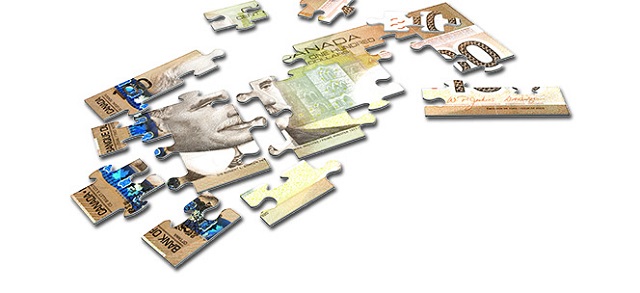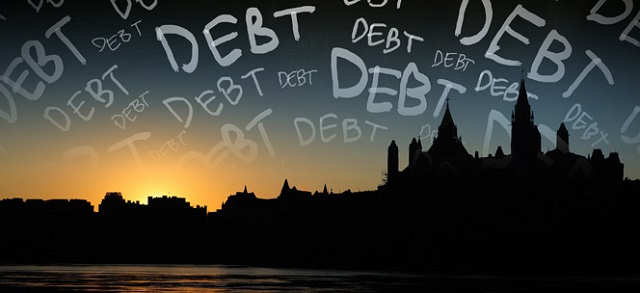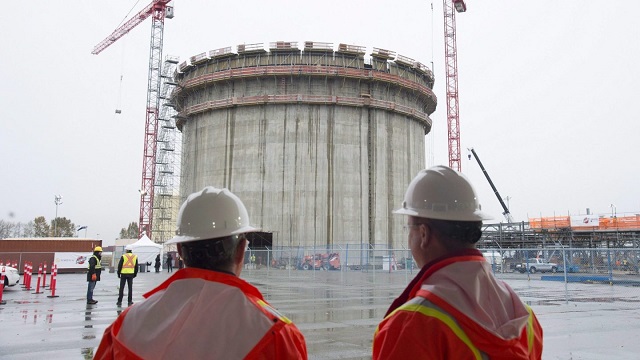Business
With our economy becalmed, Good Ship Canada needs a new captain

From the MacDonald Laurier Institute
Output has been stagnant for five years now. Canada is ‘as idle as a painted ship upon a painted ocean’
One of my favourite poems is Samuel Coleridge’s “The Rime of the Ancient Mariner.” It describes a ship driven by storms towards the South Pole. An albatross saves the ship and crew but the Ancient Mariner kills it, an act of cruelty for which he is later punished, including by having to repeat the story to strangers for the rest of his life.
It is the verse “Day after day, day after day,/ We stuck, nor breath nor motion;/ As idle as a painted ship/ Upon a painted ocean” that became one of my favourites. It comes back to me periodically when life seems stalled.
Which is the case with Canada these days. Our economy is at a standstill. Interest rates are up and inflation, though trending down, remains stubbornly high. Real GDP growth these past four quarters (August 2022 to August 2023) was a feeble 0.9 per cent. Any growth we do have is from a policy-driven population expansion of close to three per cent. But per capita GDP actually fell 2.1 per cent over that period, which means Canadians are poorer today than they were a year ago.
And it’s not just this year. Canada has been a “painted ship on a painted ocean” for some time. From January 2018 to June of this year, our GDP per capita was flat, according to OECD data released this week. Add in July and August and Canada’s per capita real GDP has declined slightly — from $52,300 in January 2018 to $51,900 in August (in 2012 dollars).
With the pandemic and surging inflation after 2020, you might think other countries’ economies are also becalmed. But they aren’t. U.S. per capita real GDP is up 2.4 per cent over the past year and up 9.3 per cent since January 2018, from US$61,500 to US$67,200 (again in 2012 dollars). At today’s exchange rate, Canada’s per capita GDP is now just 56 per cent of America’s — ouch!
Nor is it just the U.S. we’re slipping behind. Compared to our own slight decline in real per capita GDP since 2018, the OECD average is up 5.6 per cent, though there’s considerable variation across countries. For example, resource-rich Australia’s real per capita GDP was up only 4.8 per cent — which was still better than here — but superstar Ireland’s was up fully 31.0 per cent.
Let’s face it: Sir Wilfrid Laurier’s famous 1904 prediction that “For the next 100 years, Canada shall be the star towards which all men who love progress and freedom shall come” seems hollow these days. It is not that we don’t have the potential to shine; it’s that we so often fail to. We do still attract immigrants, but they often leave — as much as 20 per cent of a cohort over 25 years according to the Conference Board. And if salaries here keep falling behind those in the U.S., will we still be able to attract the best and brightest?
Canada has always been a trading nation but exports as a share of GDP have been relatively flat this past decade. The oil and gas sector has been our most important source of export earnings, surpassing even motor vehicles and parts, but since 2015 the Trudeau government has actively discouraged its growth.
We have had our share of innovations over the years but R&D spending has slipped back to the same share of GDP as it was in 1998. It seems the only way for Canada to develop new things is to subsidize them to the hilt with multi-billion grants like the ones given this past year to three different battery manufacturers.
Our health-care system is a shambles, with long waiting lines and not enough doctors and health professionals. One index ranks Canada’s health system as only 32nd best among 166 countries (with Singapore, Japan, South Korea, Taiwan and Israel ranking highest). We know what the problems are, but we seemingly don’t have the will to fix them.
Our tax system is a mess, with high rates and far too many ineffective incentives. Canada now has one of the highest top personal income tax rates in the world but applies it at much lower incomes than elsewhere, beginning at only twice the average wage. One important driver of U.S. growth was the Tax Cuts and Jobs Act of 2017, which bolstered investment by 20 per cent, as shown in important research released last month.
We are a free rider in defence and security spending, at only 1.29 per cent of GDP, well below the minimum two per cent needed to fulfil our NATO obligations. Our financial contribution to modernize NORAD is lacking despite the growing importance of the Arctic to Russia and China. We have contributed little in the way of advanced weaponry or tanks to our allies in Eastern Europe or the Middle East. Europe is desperate for natural gas but instead of buying it from us it is having to import it from Qatar.
While regional tensions have always been a major part of Canadian history, we seem to have lost all sight of nation-building. National infrastructure projects are absent. Provincial trade barriers undermine internal growth but are hard to remove. Alberta, angry with a federal government intent on shackling its energy industry, is ready to pull out of the national social security system. Quebec is drastically hiking tuition fees on students from the rest of Canada who attend its anglophone universities.
To fulfill its remarkable potential, this country cannot remain a painted ship upon a painted ocean. Someone needs to move the ship forward.
Business
When politicians gamble, taxpayers lose

From the Canadian Taxpayers Federation
Author: Jay Goldberg
Trudeau and Ford bragged about how a $5 billion giveaway to Honda is going to generate 1,000 jobs. In case you’re thinking of doing the math, that’s $5 million per job.
Politicians are rolling the dice on the electric vehicle industry with your money.
If they bet wrong, and there’s a good chance they have, hardworking Canadians will be left holding the bag.
Prime Minister Justin Trudeau and Premier Doug Ford announced a $5-billion agreement with Honda, giving another Fortune 500 automaker a huge wad of taxpayer cash.
Then Trudeau released a video on social media bragging about “betting big” on the electric vehicle industry in Canada. The “betting” part of Trudeau’s statement tells you everything you need to know about why this is a big mistake.
Governments should never “bet” with taxpayer money. That’s the reality of corporate welfare: when governments give taxpayer money to corporations with few strings attached, everyday Canadians are left hoping and praying that politicians put the chips on the right numbers.
And these are huge bets.
When Trudeau and Ford announced this latest giveaway to Honda, the amount of taxpayer cash promised to the electric vehicle sector reached $57 billion. That’s more than the federal government plans to spend on health care this year.
Governments should never gamble with taxpayer money and there are at least three key reasons why this Honda deal is a mistake.
First, governments haven’t even proven themselves capable of tracking how many jobs are created through their corporate welfare schemes.
Trudeau and Ford bragged about how a $5 billion giveaway to Honda is going to generate 1,000 jobs. In case you’re thinking of doing the math, that’s $5 million per job.
Five million dollars per job is already outrageous. But some recent reporting from the Globe and Mail shows why corporate welfare in general is a terrible idea.
The feds don’t even have a proper mechanism for verifying if jobs are actually created after handing corporations buckets of taxpayer cash. So, while 1,000 jobs are promised through the Honda deal, the government isn’t capable of confirming whether those measly 1,000 jobs will materialize.
Second, betting on the electric vehicle industry comes with risk.
Trudeau and Ford gave the Ford Motor Company nearly $600 million to retool a plant in Oakville to build electric cars instead of gasoline powered ones back in 2020. But just weeks ago, Ford announced plans to delay the conversion for another three years, citing slumping electric vehicle sales.
Look into Ford’s quarterly reports and the danger of betting on electric vehicles becomes clear as day: Ford’s EV branch lost $1.3 billion in the first quarter of 2024. Reports also show Ford lost $130,000 on every electric vehicle sold.
The decline of electric vehicle demand isn’t limited to Ford. In the United States, electric vehicle sales fell by 7.3 per cent between the last quarter of 2023 and the first quarter of 2024.
Even Tesla’s sales were down 13 per cent in the first quarter of this year compared to the first quarter of 2023.
A Bloomberg headline from early April read “Tesla’s sales miss by the most ever in brutal blow for EVs.”
There’s certainly a risk in betting on electric vehicles right now.
Third, there’s the question of opportunity cost. Imagine what else our governments could be doing with $57 billion?
For about the same amount of money, the federal government could suspend the federal sales tax for an entire year. The feds could also use $57 billion to double health-care spending or build 57 new hospitals.
The solution for creating jobs isn’t to hand a select few companies buckets of cash just to lure them to Canada. Politicians should be focusing on creating the right environment for any company, large or small, to grow without a government handout.
To do that, Canada must be more competitive with lower business taxes, less red tape and more affordable energy. That’s a real recipe for success that doesn’t involve gambling with taxpayer cash.
It’s time for our politicians to kick their corporate welfare addiction. Until they do, Canadians will be left paying the price.
Business
WEF panelist suggests COVID response accustomed people to the idea of CBDCs

Central Bank of Bahrain governor Khalid Humaidan
From LifeSiteNews
When asked how he would convince people that CBDCs would be a trusted medium of exchange, Bahrain’s central bank governor said that COVID made the digital transformation ‘something of a requirement’ that had ‘very little resistance.’
Central bank digital currencies (CBDCs) will hopefully replace physical cash and become fully digital, a central banker tells the World Economic Forum (WEF).
Speaking at the WEF Special Meeting on Global Collaboration, Growth and Energy Development on Sunday, Central Bank of Bahrain governor Khalid Humaidan told the panel “Open Forum: The Digital Currencies’ Opportunity in the Middle East” that one of the goals of CBDC was to replace cash, at least in Bahrain, and to go “one hundred percent digital.”
Humaidan likened physical cash to being an antiquated “analogue” technology and that CBDC was the digital solution that would hopefully replace cash:
"We're probably going to stop calling it central bank digital currency [CBDC]. It's going to be a digital form of cash, and at some point in time hopefully we will be able to be 100% digital": Central Bank of Bahrain Governor Khalid Humaidan to the WEF https://t.co/Pspr0M1Uuq pic.twitter.com/N5aOkCpzh1
— Tim Hinchliffe (@TimHinchliffe) April 29, 2024
“I thank this panel and this opportunity. It forced me to refine my thoughts and opinions where I’m at a place comfortably now that I’m ready to verbalize what I think about CBDC,” said Humaidan.
If we think cash is the analogue and digital currency is the form of digital – CBDC is the digital form of cash – today, clearly we’re in a hybrid situation; we’re using both.
We know in the past when it comes to cash, central bankers were very much in control with all aspects of cash, and now we’re comfortable to the point where the private sector plays a big role in the printing of the cash, in the distribution of the cash, and with the private sector we use interest rates to manage the supply of cash.
The same thing is likely to happen with CBDC. Yes, the central bank will have a role, but at some point in time – the same way we don’t call it ‘central bank cash’ – we’re probably going to stop calling it central bank digital currency.
“It’s going to be a digital form of the cash, and at some point in time hopefully we will be able to be one hundred percent digital,” he added.
When asked how he would convince people that CBDC would be a trusted medium of exchange, Bahrain’s central bank governor said that people were already used to it and that COVID made the digital transformation “necessary” and “something of a requirement” that had “very little resistance.”
"There's less use of cash […] The transition to fully digital is not going to be a stretch […] People are used to it […] Its adoption rates increased because of COVID […] There is very little resistance": Central Bank of Bahrain Governor Khalid Humaidan to the WEF on CBDC pic.twitter.com/zB7nJAi48G
— Tim Hinchliffe (@TimHinchliffe) April 29, 2024
“Right now, many of our payments are digital. The truth is, I said that we’re in a hybrid model; there’s less and less use of cash,” said Humaidan.
I think from predominantly digital with a little physical, I think the transition to fully digital is not going to be a stretch.
People are used to it, people have engaged in it and certain circumstances did help. Its adoption rates increased because of COVID.
“This is where contactless started to become something of a necessity, something of safety, something of a requirement, and because of that there is very little resistance; trust is already there,” he added.
"Is it [digital euro] going to be as private as cash? No. A digital currency will never be as anonymous and as protecting of privacy in many respects as cash, which is why cash will always be around": Christine Lagarde, BIS Innovation Summit, March 2023 #CBDC pic.twitter.com/BLMVOPax6a
— Tim Hinchliffe (@TimHinchliffe) April 11, 2023
Meanwhile, European Central Bank president Christine Lagarde has been going around the world telling people that the digital euro CBDC would not eliminate cash, and that cash would always be an option.
Speaking at the Bank for International Settlements (BIS) Innovation Summit in March 2023, Lagarde said that a digital currency will never be as anonymous as cash, and for that reason, cash will always be around.
“Is it [digital euro] going to be as private as cash? No,” she said.
A digital currency will never be as anonymous and as protecting of privacy in many respects as cash, which is why cash will always be around.
If people want to use cash in some countries or in some transactions, cash should be available.
“A digital currency is an alternative, is another means of payment and will not provide exactly the same level of privacy and anonymity as cash, but will be pretty close in terms of complete neutrality in relation to the data,” she added.
A WEF Agenda blog post from September, 2017, lists the “gradual obsolescence of paper currency” as being “characteristic of a well-designed CBDC.”
"You could have a potentially […] darker world where the government decides that [CBDC] can be used to purchase some things, but not other things that it deems less desirable like say ammunition, or drugs, or pornography, or something of the sort": Eswar Prasad, WEF #AMNC23 pic.twitter.com/KkWgaEWAR5
— Tim Hinchliffe (@TimHinchliffe) June 28, 2023
Last year at the WEF’s 14th Annual Meeting of the New Champions, aka “Summer Davos,” in Tianjing, China, Cornell University professor Eswar Prasad said that “we are at the cusp of physical currency essentially disappearing,” and that programmable CBDCs could take us to either a better or much darker place.
“If you think about the benefits of digital money, there are huge potential gains,” said Prasad, adding, “It’s not just about digital forms of digital currency; you can have programmability – units of central bank currency with expiry dates.
You could have […] a potentially better – or some people might say a darker world – where the government decides that units of central bank money can be used to purchase some things, but not other things that it deems less desirable like say ammunition, or drugs, or pornography, or something of the sort, and that is very powerful in terms of the use of a CBDC, and I think also extremely dangerous to central banks.
The WEF’s Special Meeting on Global Collaboration, Growth and Energy Development took place from April 27-29 in Riyadh, Saudi Arabia.
“Saudi Arabia’s absolute monarchy restricts almost all political rights and civil liberties,” according to D.C.-based NGO Freedom House.
In the kingdom, “No officials at the national level are elected,” and “the regime relies on pervasive surveillance, the criminalization of dissent, appeals to sectarianism and ethnicity, and public spending supported by oil revenues to maintain power.”
Reprinted with permission from The Sociable.
-

 Uncategorized2 days ago
Uncategorized2 days agoMaking Alberta a geothermal energy leader
-

 Alberta2 days ago
Alberta2 days agoAlberta’s vision for passenger rail
-

 COVID-192 days ago
COVID-192 days agoStates move to oppose WHO’s ‘pandemic treaty,’ assert states’ rights
-

 Business2 days ago
Business2 days agoParliamentary Budget Officer forecasts bigger deficits for years to come
-

 Addictions2 days ago
Addictions2 days agoMust Watch: Addiction worker estimates 90% of “safer supply” drugs resold on black market
-

 conflict1 day ago
conflict1 day agoColumbia on Lockdown After pro-Palestinian Protesters Take Over Building, Hold Janitors Hostage
-

 Canadian Energy Centre1 day ago
Canadian Energy Centre1 day agoNorth America LNG project cost competitiveness
-

 Business1 day ago
Business1 day agoWEF panelist suggests COVID response accustomed people to the idea of CBDCs






